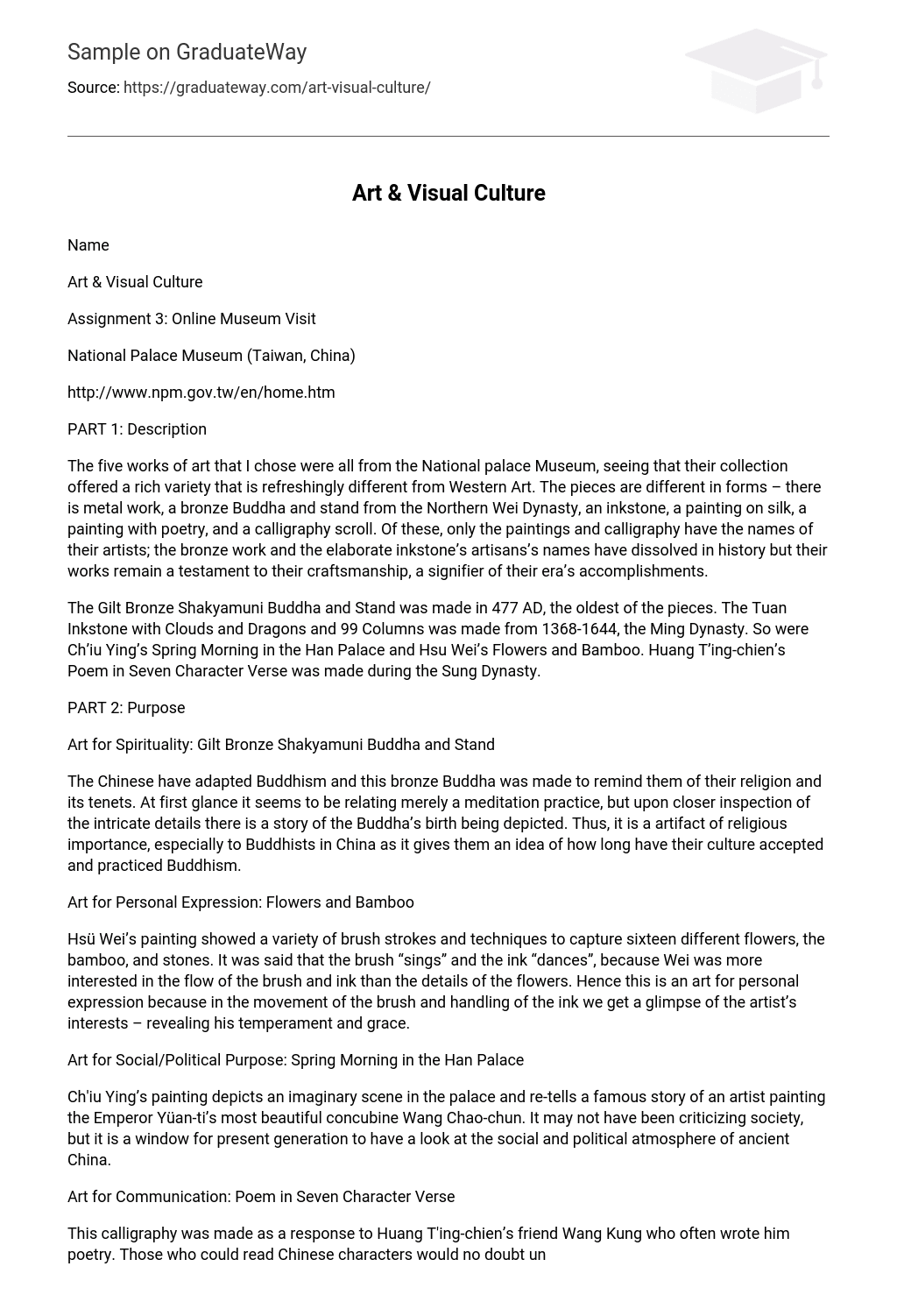Description
The five works of art that I chose were all from the National palace Museum, seeing that their collection offered a rich variety that is refreshingly different from Western Art. The pieces are different in forms – there is metal work, a bronze Buddha and stand from the Northern Wei Dynasty, an inkstone, a painting on silk, a painting with poetry, and a calligraphy scroll. Of these, only the paintings and calligraphy have the names of their artists; the bronze work and the elaborate inkstone’s artisans’s names have dissolved in history but their works remain a testament to their craftsmanship, a signifier of their era’s accomplishments.
The Gilt Bronze Shakyamuni Buddha and Stand was made in 477 AD, the oldest of the pieces. The Tuan Inkstone with Clouds and Dragons and 99 Columns was made from 1368-1644, the Ming Dynasty. So were Ch’iu Ying’s Spring Morning in the Han Palace and Hsu Wei’s Flowers and Bamboo. Huang T’ing-chien’s Poem in Seven Character Verse was made during the Sung Dynasty.
Purpose
Art for Spirituality: Gilt Bronze Shakyamuni Buddha and Stand
The Chinese have adapted Buddhism and this bronze Buddha was made to remind them of their religion and its tenets. At first glance it seems to be relating merely a meditation practice, but upon closer inspection of the intricate details there is a story of the Buddha’s birth being depicted. Thus, it is a artifact of religious importance, especially to Buddhists in China as it gives them an idea of how long have their culture accepted and practiced Buddhism.
Art for Personal Expression: Flowers and Bamboo
Hsü Wei’s painting showed a variety of brush strokes and techniques to capture sixteen different flowers, the bamboo, and stones. It was said that the brush “sings” and the ink “dances”, because Wei was more interested in the flow of the brush and ink than the details of the flowers. Hence this is an art for personal expression because in the movement of the brush and handling of the ink we get a glimpse of the artist’s interests – revealing his temperament and grace.
Art for Social/Political Purpose: Spring Morning in the Han Palace
Ch’iu Ying’s painting depicts an imaginary scene in the palace and re-tells a famous story of an artist painting the Emperor Yüan-ti’s most beautiful concubine Wang Chao-chun. It may not have been criticizing society, but it is a window for present generation to have a look at the social and political atmosphere of ancient China.
Art for Communication: Poem in Seven Character Verse
This calligraphy was made as a response to Huang T’ing-chien’s friend Wang Kung who often wrote him poetry. Those who could read Chinese characters would no doubt understand the poetry this calligraphy speaks of, but for those who do not the artistry and fluidity of the characters are still more than enough to leave us mesmerized.
Art for Day-to-Day Living: Tuan Inkstone with Clouds and Dragons and 99 Columns
Since this particular inkstone enjoyed the Emperor’s appreciation, it may be dubious whether it was used for day-to-day living after it found its way to the Emperor’s Summer Residence, but before then this must have been used by a scholar, poet, or artist for their landscape painting and/or calligraphy. Inkstones were of utmost importance during that time, when they prepared their own ink for various uses.
Design Principles
The one I like best is the Tuan Inkstone with Clouds and Dragons and 99 Columns. The craftsman made use of various design principles, integral is the use of the “eye” that creates attraction to the 99 columns because each column is built with its own “eye”. These eyes are naturally occurring in the Tuan stone, and the grayish black color of the stone contrasted well with the bright yellowish-green oval eyes.
Further, the ink well area, the top section, is carved with clouds and dragons, with a giant dragon leading nine baby dragons. This intricate carving receives emphasis because the rest of the top side is flat. And then all the sides of the inkstone has Chinese characters script, at one side contains a poem regarding the inkstone, on the right and left sides bearing the name and location where it is kept respectively, giving the inkstone more than just mere function but a sense of balance as well, each part has its own artistic design that adds to the beauty of the whole.
Conclusion
What really attracted me to the Tuan Inkstone was its intricate carving of clouds and dragons, and the columns with the eyes on its reverse side. I have never imagined that an inkstone, something that they use to grind their ink and for everyday use would be so elaborately designed, and after all these years it still remains a work of craftsmanship and utility. With one look one could already see the richness of texture of the rock used, and then one can imagine the labor and skill that was needed to make the dragons and the clouds.
I learned what the inscriptions meant after I studied the piece – it was marveling, pondering at the eyes that seem to be staring at the viewer, and it showed me a glimpse of Chinese thinking. Here is an inkstone, something that they use everyday and yet Art was an important aspect too, and with Art they pondered on the beauty and impression that it gave them.





